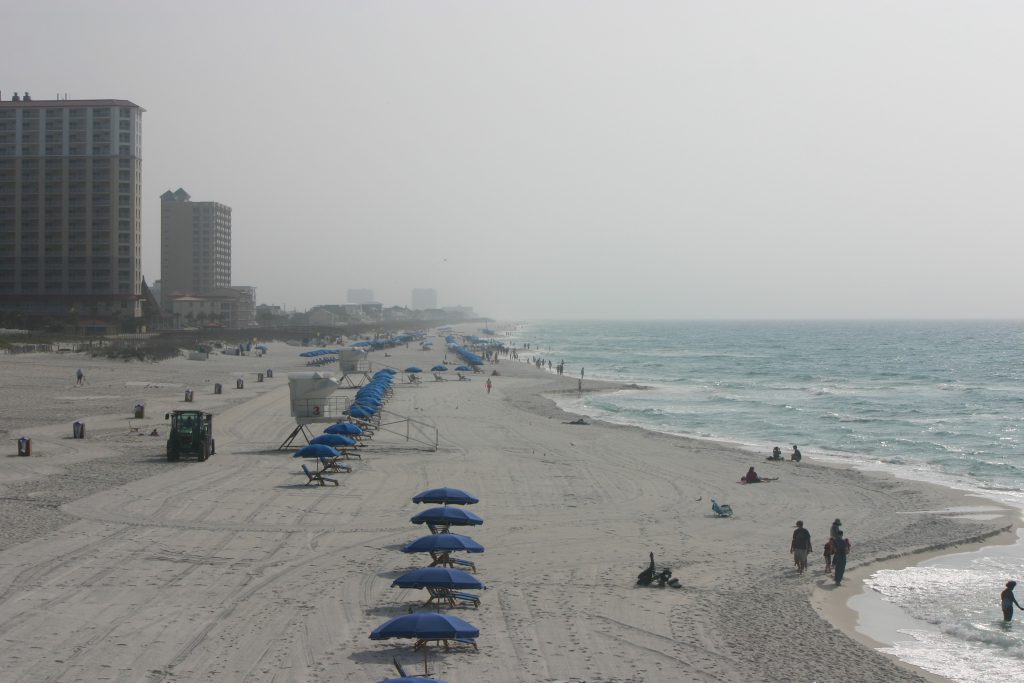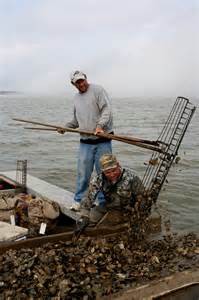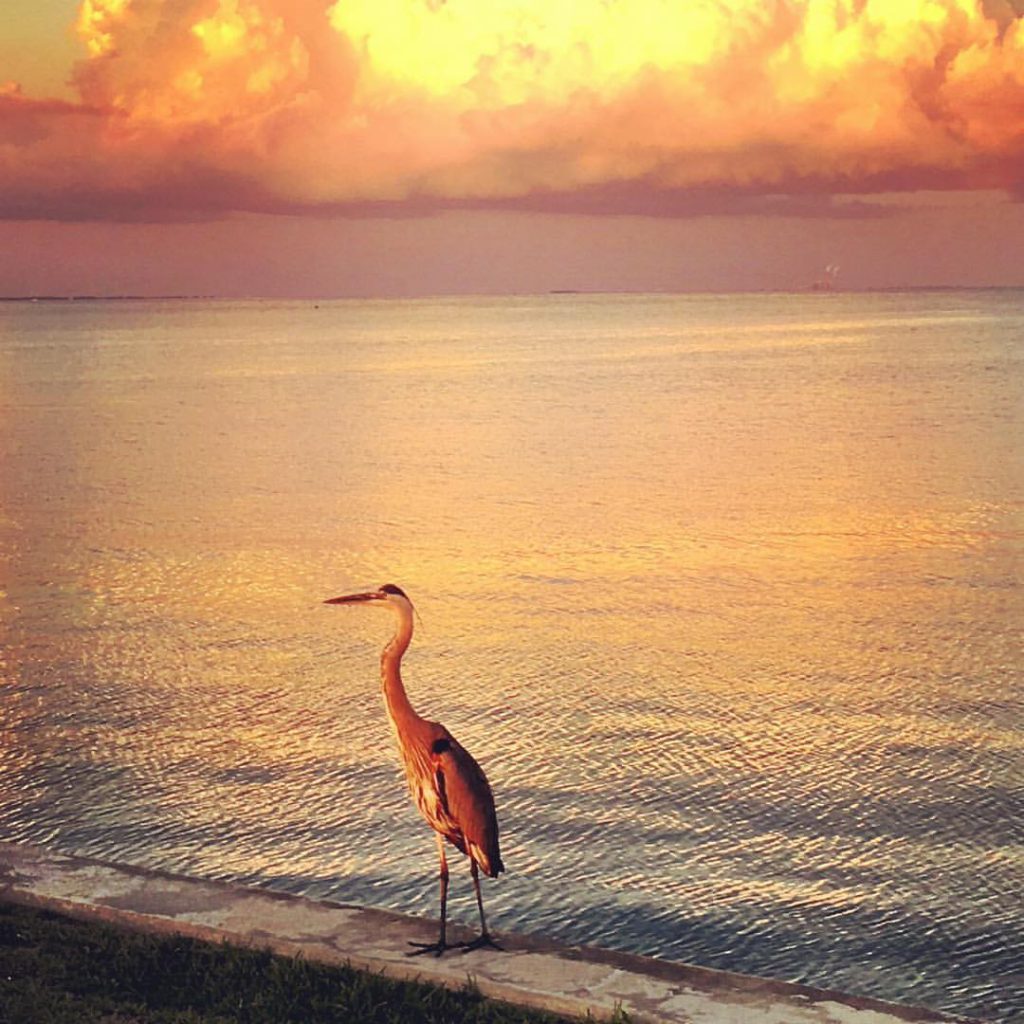
The threat of bacteria in coastal waters can be scary and a challenge to understand. Here is information that helps clarify the threat to beach visitors and recreational users of marine waters. This is a good opportunity to think about bacteria exposure risks related to the coastal environment that we can control. It is important to remember the probability of severe illness in a normal healthy individual is very low.
There are two different un-related groups of bacteria species that often are cited in the news. One general group is fecal coliform and the other group are marine specific known as Vibrio.
Fecal coliform including Enterococci bacteria are used by public health managers as indicators of water quality. High levels of these bacteria can indicate an elevated health risk for beach visitors. For some individuals contact in impacted waters can result in gastrointestinal issues like nausea, vomiting, stomachache, diarrhea, headache or fever. Other symptoms might include rashes, sore throat, ear ache, and other cold-like or upper respiratory symptoms.
When “no-swimming” advisories are posted you can avoid these concerns by following warning and guidance information. Many times advisories are for specific locations due to storm run-off and water circulation patterns. If an area has a warning or is closed, usually there are better choices for swimming activities nearby. The Florida Department of Health has an established testing of many of Florida’s coastal swimming areas. The latest guidance information can be found at http://www.floridahealth.gov/environmental-health/beach-water-quality
On the other hand, Vibrio exposure that results in illness is potentially more severe. The US Centers for Disease Control and Prevention now estimate 80,000 Vibrio illnesses and 100 deaths occur annually in the United States. In perspective, The Clean Beaches Coalition estimates 180 million Americans annually make 2 billion visits to ocean, gulf and inland beaches.
According Georgia Sea Grant’s SafeOysters.org website and research, many Vibrio infections are not reported and usually do not cause serious or life-threatening illness in healthy people, although they may cause gastroenteritis (nausea, abdominal pain, vomiting, and/or diarrhea) or cellulitis (skin infection). For a Vibrio infection to occur there must be an entry point into the body. This usually is either through water entering an open wound or eating raw or undercooked seafood.
Symptoms of infection due to consumption of raw or undercooked seafood often develop in 12 to 48 hours and may include:
-
Fever/chills
-
Nausea/stomach pain/vomiting
-
Diarrhea
Individuals with weakened immune systems, chronic diseases or conditions, or undergoing certain medical treatments (see list below) are more susceptible to Vibrio vulnificus infections and are also more likely to become seriously ill or die from them. The fatality rate may be as high as 61% for Vibrio vulnificus infections in people that have been diagnosed with one or more of the following health conditions:
-
Liver disease (from cirrhosis, hepatitis, or cancer)

No need to feel left out! Fully cooked oyster dishes like Oysters Rockefeller are a coastal classic that’s safe and tastes great! Photo by Florida Department of Agriculture and Consumer Services. -
Diabetes
-
Alcoholism
-
Kidney disease or failure
-
Cancer (includes lymphoma, leukemia, and Hodgkin’s disease)
-
HIV/AIDS
-
Stomach disorders including surgery, taking acid reflux medication or antacids
-
Hemochromatosis (iron overload disease)
* If you are unsure of your risk, consult your doctor. You can always indulge in great oyster recipes that are fully cooked like Oyster Rockefeller or oyster chowder.
Perhaps one of the most common group of listed individuals are those taking acid reflux or heartburn medications. This would also include antacids and prescription medications for acid reflux and other common digestive conditions. Many of these medications work by reducing acid which can potentially increase pH in the digestive system. This lowers the natural defense barrier to several foodborne bacteria including Vibrio. If you take these medications do not eat raw or under cooked seafood. If you have any question about your risk, consult your doctor.

Photo: Sea Grant
Shellfish harvesting is managed by the Florida Department of Agriculture and Consumer Services – Division of Aquaculture and Florida Fish and Wildlife Commission. This is done in cooperation with Florida’s certified shellfish harvesters and processors. While Vibrio counts may be higher in warmer weather, shellfish harvest areas are monitored all year. A system of specific harvest protocols are consistently maintained. Florida’s regulatory agencies and seafood industries work together with the goal of having the safest shellfish supply at all times of the year.
As mentioned earlier, Vibrio can also enter the body through open wounds. Vibrio is sometimes misnamed as “flesh-eating” bacteria. “Flesh-eating” is not a medical term and was likely derived from the fact that tissue death, or necrosis, can occur during advanced, late stages of infection around a wound if it is left untreated, especially in those with weakened immune systems (Oliver 2005). The best advice is to seek medical attention early if you experience any of these symptoms or have suffered cut or puncture injury in coastal waters. (See Vibrio FAQs from UF/IFAS and Florida Sea Grant)

Wound infection symptoms may develop within 3 to 24 hours and include:
-
Rapid swelling, pain, and reddening of skin around wound (present in 100% of infections)
-
Large blisters, die-off of tissue around wound (30 – 50% of infections)
-
Gangrene (<10%)
If Vibrio vulnificus infections are left untreated in people at risk for serious infection, symptoms may quickly increase in severity and include:
-
Fluid accumulation, especially in legs
-
Blood-filled large blisters, mainly on extremities
-
Septicemia (bacteria enter and spread through blood stream)
-
Shock (rapid drop in blood pressure)
-
Death
For additional information and details please visit SafeOysters.org
Here are some final thoughts and advice:
-
Remember the majority of healthy individuals will not have any problems.
-
If you are recovering from illness know your limits and use the above resources to make informed decisions to protect your health.
-
Plan your beach vacation for safety but then confidently relax and enjoy the experience.
-
For additional beach safety and enjoyment of our natural resources see our other articles on the UF/IFAS Panhandle Outdoors website.

An Equal Opportunity Institution. UF/IFAS Extension, University of Florida, Institute of Food and Agricultural Sciences, Nick T. Place, dean for UF/IFAS Extension. Single copies of UF/IFAS Extension publications (excluding 4-H and youth publications) are available free to Florida residents from county UF/IFAS Extension offices.
 0
0


Comments:
May 28, 2021
You will need the minus sign. In the ArcGIS search box type in the Decimal Degree conversion. for Fountain Bleu Box Cars -85.8833, 30.15 https://arcg.is/ubaHD
May 2, 2021
How do you put the negative number when I try to enter without no (-) tells me I am 4,000 miles away
April 26, 2019
Just a quick note thanking you all for providing valuable recovery information and tools.
February 13, 2019
Hi Susan, Registration opened on the 11th, and future events will also be 10 days before the event. The link to register is here https://uf_ifas_part2_shrubs.eventbrite.com If you have any trouble getting signed up please email me at juliebmcconnell@ufl.edu. I apologize for the delayed response, notifications on the website are not sent directly to me. Julie
January 20, 2019
Hi Julie, When do you expect to open up ticket purchases for the next seminar on February 21st? Thank you so much for these series! Susan Higby
July 3, 2016
Latest release from Health Department in Bay County / Bay County TDC via Twitter June 28, 2016 https://twitter.com/Visit_PCB/status/748315619682983936
June 17, 2016
Yes, I had a call about this problem this morning, they are here in Bay County
May 6, 2016
I noticed aphids on my lettuce and planned to take them in to show some students. On the planned date I found they they had been consumed by parasitic wasps. I felt it was a sign of a balanced ecosystem.
February 3, 2016
Where can I find seed potatoes (red)? I am in Gulf Breeze.
July 22, 2015
I was actually wondering about the issue with the mower blades. I am constantly getting the ends of the grass cut on a way that has the tip of it drying out. Is the fact that the blades are a little worn, that is causing this issue of the grass getting dry at the top.
June 8, 2015
For sure on the Aucuba! I love it and use it throughout my front yard along with the cast iron plants. One of my favorite shade plants however is the Apostle's Iris, 'Neomarica gracilis'. They have survived the coldest winters so far and have come back beautifully. Thanks for the article. I have 2 shady beds I am renovating right now so I look forward to finding the Japanese Plum Yew and the Mahonia!
April 19, 2015
An evergreen shrub that does well in the shade for me is Aucuba japonica 'Serratifolia' An all green aucuba.
April 15, 2015
Nice article Julie. Just a side note that occurred to me as I looked at the pictures. Please don't recommend (I know you didn't in this article) that people plant close to the flare roots of a tree. The first radial distance of 3x the DBH of the tree is very, very important root area and what the arborist needs access to for many treatments. As important, perhaps more important is: 1. the tree trunk and exposed flare roots need to be dry when it is not raining and having vegetation in close proximity eliminates the breeze and keeps the tree trunk damp creating a decay/fungi opportunity; 2. cast iron plant, Jasmine, fern, etc. are major competitors in that critical root area. If a tree is stressed one of the cultural remedies is to clear out plants in that critical root area and install organic mulch, preferably pine straw. Keep up the good work!!
March 26, 2015
Hi Stan, I don't know how frequently that is done, however, if the gardener plans to change out the plants after a very short period of time they may leave them in containers. Some commercial properties may do that if they plan to swap out if anything declines (theme parks, other high profile spots), but most plants should not stay in original containers indefinitely. Eventually the plant's root system will outgrow the pot and will be unable to take up enough water to sustain itself. Julie
March 14, 2015
Miss McConnell, Is it a common practice by some homeowners to leave the annuals in their pots when they plant them in the Spring? Thank you
December 5, 2014
Hi David, The palm you are describing is likely Butia capitata also known as Jelly Palm or Pindo Palm. The fronds have a bit of a blueish or silvery color to them that makes them fairly distinctive. More can be found about this palm at the following link http://edis.ifas.ufl.edu/pdffiles/ST/ST10500.pdf. If you like, send a picture to my email and I can confirm if that's what you have. Have a great day! Julie juliebmcconnell@ufl.edu
December 4, 2014
We have a palm, locally known as a Jelly Palm" It's a very slow growing, like 12 feet in 15 years, and very bushy compared to the typical King palm. It puts out small groups of flowers, inside a hard, 3-4 ft. long woodlike, split, shell, which, of course become seeds. That is apparently what some old timers used for "Jelly:". Jelly Palm is not likely it's correct name. From that vague description, can you tell me what it is, or if not, what I can provide to help properly name it.
November 5, 2014
Please give me a call. I would like to discuss how Farm Credit can be involved in this program. My number is 850-718-5511. Thanks, Lesia Andrews
September 7, 2014
Hi John, Butterflies are rather specific about where they lay eggs and which plants their larvae (caterpillars) will feed on. For the Gulf Fritillary, the passionflower vine is the preferred larval host. I would not expect having this plant in your garden would have any direct effect on the number of caterpillars that would target tomatoes and peppers. If you would like to learn more about pests that are more specific to tomatoes and peppers, please see the following publication at http://edis.ifas.ufl.edu/pdffiles/IN/IN16900.pdf "Insect Management for Tomatoes, Peppers, and Eggplant"
September 3, 2014
if I plant this purple passionflower....will caterpillars start eating my tomatoes and green bell peppers. Thanks John Nelson
July 3, 2014
Glad to hear it, have a wonderful weekend!
July 3, 2014
Worked like a charm!
July 3, 2014
Hi Suzy, The link should take you to a leaflet publication by USDA Forest Service titled "Walnut Caterpillar." I checked the link embedded in the article and it is working tonight, but sometimes there can be other issues. I am adding the link below in plain text so that you can try to copy and paste into your internet browser. If you are still unable to access it I would be happy to scan it and send it to you directly as a .pdf in an email next week. Julie http://www.na.fs.fed.us/spfo/pubs/fidls/walnutcat/walnutfidl.htm
July 2, 2014
Your link to the US Forest Service is not valid
February 19, 2014
It would be great if you would submit this article for newspaper publication, especially Tallahassee Democrat. There are so many people that are misinformed about lichens and Spanish moss. Donna Legare Native Nurseries
December 3, 2013
Enjoyed your article. Wish I had time to plant winter annuals.
November 25, 2013
Noticed one of our longleaf pine saplings, in the middle stage has died out on the top 3" of the bud. The trunk and several lower limbs still have healhty green looking growth buds. We are located 3 blocks north of the Gulf of Mexico in Franklin County Fla. elevation +27' sandy soil. Approximately 25 trees are @200yr old, some cat faced. Another 50 trees are post turpentine era, and another 75 are in the grass and middle stages. We eliminated all the loblolly pine 10yrs ago in hopes of restoring the longleaf presence on our 4+acres. Regards, Paul Standish
November 19, 2013
Thank you, Phil!
November 19, 2013
Excellent article! One of your M.G.'s ...Phil_Smith...
September 10, 2013
What type of grass do you have? If you have centipede, you will not need any additional fertilizer for the season. How much did you put out in August/
September 10, 2013
Applied fertilizer to grass early August as I was away for 5-6 months. Can I apply again on 9/15?
January 10, 2013
January 10, 2013
November 14, 2012
Have any favorite seafood recipes for the Holidays or maybe a treasured family memory? Post a comment and share!
Comments are closed.